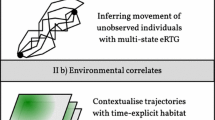Abstract
Multi-state mark–recapture models are structurally complex models, and in particular the complexity increases when there are unobservable states. Until recently, determining whether or not such models were parameter redundant was only possible numerically. In this paper, we show how it now possible to examine parameter redundancy of such models symbolically. The advantage of this approach is that you can determine exactly how many parameters can be estimated in a model for any number of years of marking and recovery, as well as which combinations of parameters can be estimated. Here, we illustrate how the new methodology works for multi-state models. We further develop rules for determining the parameter redundancy status of a whole family of multi-state mark–recapture models.
Similar content being viewed by others
References
Catchpole EA, Morgan BJT (1997) Detecting parameter redundancy. Biometrika 84:187–196
Catchpole EA, Morgan BJT, Freeman SN (1998) Estimation in parameter redundant models. Biometrika 85:462–468
Catchpole EA, Kgosi PM, Morgan BJT (2001) On the near singularity of models for animal recovery data. Biometrics 57:720–726
Choquet R, Rouan L, Pradel R (2009) Program E-SURGE: a software application for fitting Multievent models. In: Thomson DL, Cooch EG, Conroy MJ (eds) Environmental and ecological statistics series, vol 3. Springer, Berlin, pp 845–865
Clobert J, Lebreton JD, Allaine D, Gaillard JM (1994) The estimation of age-specific breeding probabilities from recaptures or resightings in vertebrate populations: II. Longitudinal models. Biometrics 50:375–387
Cole DJ, Morgan BJT (2010a) A note on determining parameter redundancy in age-dependent tag return models for estimating fishing mortality, natural mortality and selectivity. J Agric Biol Environ Stat. doi:https://doi.org/10.1007/s13253-010-0026-6
Cole DJ, Morgan BJT (2010b) Detecting parameter redundancy in covariate models. Biometrika. doi:https://doi.org/10.1093/biomet/asq041
Cole DJ, Morgan BJT, Titterington DM (2010) Determining the parametric structure of non-linear models. Math Biosci (in press)
Corless RM, Jeffrey DJ (1997) The turing factorization of a rectangular matrix. Sigsam Bull 31:20–28
Cormack RM (1964) Estimates of survival from the sightings of marked animals. Biometrika 51:429–438
Gimenez O, Choquet R, Lebreton J (2003) Parameter redundancy in multistate capture–recapture models. Biom J 45:704–722
Gimenez O, Viallefont A, Choquet R, Catchpole EA, Morgan BJT (2004) Methods for investigating parameter redundancy. Anim Biodivers Conserv 27:561–572
Hunter CM, Caswell H (2009) Rank and redundancy of multi-state mark-recapture models for seabird populations with unobservable states. In: Thomson DL, Cooch EG, Conroy MJ (eds) Environmental and ecological statistics series: vol 3. Springer, Berlin, pp 797–826
Jiang H, Pollock KH, Brownie C, Hightower JE, Hoenig JM and Hearn WS (2007) Age-dependent tag return models for estimating fishing mortality, natural mortality and selectivity. J Agric Biol Environ Stat 12:177–194
Jolly GM (1965) Explicit estimates from capture–recapture data with both death and immigration. Biometrika 52:225–247
Mackenzie DI, Nichols JD, Seamans ME, and Gutierrez RJ (2009) Modeling species occurrence dynamics with multiple states and imperfect detection. Ecology 90:823–835
Pledger S, Efford M, Pollock K, Collazo J, Lyons J (2009) Stopover duration analysis with departure probability dependent on unknown time since arrival. In: Thomson DL, Cooch EG and Conroy MJ (eds) Ecological and environmental statistics series, vol 3. Springer, Berlin, pp 349–363
Rouan L, Choquet R, Pradel R (2009) A general framework for modeling memory in capture–recapture data. J Agric Biol Environ Stat 14:338–355
Seber GAF (1965) A note on the multiple recapture census. Biometrika 52:249–259
Viallefont A, Lebreton JD, Reboulet AM, Gory G (1998) Parameter identifiability and model selection in capture–recapture models: a numerical approach. Biom J 40:1–13
Acknowledgments
Thanks to Byron Morgan, the session chair and two referees for their comments on this paper, and to Christine Hunter for her description of multi-state mark–recapture models for seabird populations.
Author information
Authors and Affiliations
Corresponding author
Additional information
Communicated by M. Schaub.
Electronic supplementary material
Below is the link to the electronic supplementary material.
Rights and permissions
About this article
Cite this article
Cole, D.J. Determining parameter redundancy of multi-state mark–recapture models for sea birds. J Ornithol 152 (Suppl 2), 305–315 (2012). https://doi.org/10.1007/s10336-010-0574-0
Received:
Revised:
Accepted:
Published:
Issue Date:
DOI: https://doi.org/10.1007/s10336-010-0574-0




